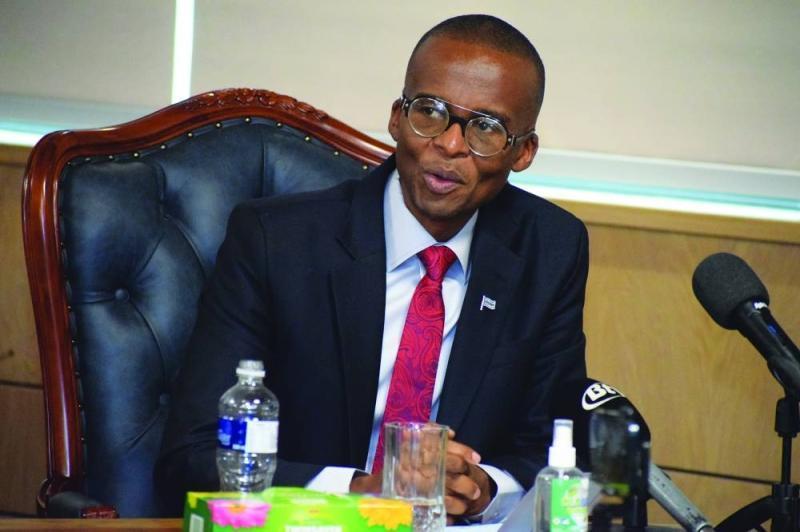Africa-Press – Botswana. The IMF now expect Botswana’s economy to contract by about 0.4% this year, while the World Bank now projects 0.6% growth. Both reductions are largely due to the threat of Trump tariffs, which now make government’s original hope of 3.3% growth unlikely. MBONGENI MGUNI writes
The International Monetary Fund (IMF) is today (Friday) expected to brief on its expectations of how the economies of sub-Saharan Africa will likely perform in 2025. This area of the globe is in a form of economic stasis, after US President, Donald Trump, hit it with some of his highest planned trade tariffs recently, before suspending the move for 90 days.
Botswana faces a 37% tariff knock on its exports to the US, while Lesotho could be hit with 50% and South Africa 30%.
That uncertainty is reverberating across the world and for Botswana, is manifesting the most in the diamond sector, the sensitive backbone of the country and one which all policymakers are eyeing to lift the economy from its three percent recession in 2023.
The rough diamond pipeline from the mines in Jwaneng and Orapa, leads to centres in India, Dubai and Antwerp before heading to the United States which accounts for about 54% of annual processed diamond demand.
Trump’s tariff threat hovers above each of these centres, in turn throwing the carefully and optimistically calculated growth forecasts by the Finance Ministry into disarray.
“Botswana’s external outlook remains uncertain, as it is closely linked to fluctuations in the diamond market,” the World Bank said on Wednesday in its Africa Pulse update.
Besides making diamonds more expensive for US consumers, the planned tariffs are already rattling consumer sentiment in that country, threatening higher inflation and tighter disposable incomes – both of which are terrible news for diamond sales.
US markets have been roiled while the introduction, then pause of the tariff action, as well as subsequent escalation of a trade standoff with China, have put the US economy on edge.
In a year in which local policymakers were expecting to see a turnaround in the prolonged diamond downturn by at least July, the trade tariffs have ushered in an unwelcome uncertainty.
Finance Minister, Ndaba Gaolathe, in his February budget speech, spoke about the link between the recovery in diamonds and growth this year.
“In 2025, the economy is projected to grow below its potential at 3.3 percent,” he said. “This growth outlook is premised on the recovery of the diamond industry which is expected in the latter part of 2025 and continued positive sentiments in the non-diamond mining sectors.”
Almost prophetically, he added: “Our macroeconomic environment remains uncertain and subject to significant downside risks. “The risk of intensified geopolitical tensions, climate shocks and global trade fragmentation driven by escalating tariff disputes between major economies such as China and the United States or the Eurozone is also eminent.”
Trump has put paid to these fears and the fact that the US administration, nearly on a daily basis, changes direction, escalating its threats, then backtracking and attempting to ease fears, means the diamond industry at this point cannot even attempt to plan a response towards a recovery.
The IMF, in its eagerly-awaited April World Economic Outlook, cut its forecast for Botswana’s growth this year to negative 0.4% from an October projection of 5.2%. Again, the uncertainty in the global economy was a major factor.
In fact, the World Economic Outlook released on Wednesday shaved the global growth forecast by half a percentage point to 2.8% for 2025 and by 0.3 percentage points for 2026.
The IMF made downward revisions in growth for nearly all countries, citing the turbulence caused by the global trade upheaval.
“The downgrades are broad-based across countries and reflect in large part the direct effects of the new trade measures and their indirect effects through trade linkage spillovers, heightened uncertainty, and deteriorating sentiment,” IMF researchers said.
For its part, the World Bank noted that while African countries were not major exporters to the US, with America accounting for just five percent of total sub-Saharan global exports, the impact of the trade wars could be transmitted to the continent in other ways.
These include weaker growth in key trading partners which would reduce demand for African exports, reduced foreign investment and aid from other countries and monetary policy tightening in major economies which would price African economies out of the global financial markets.
How hard these effects could hit individual African countries depends on their economic structure, as well as key indicators such as levels of reserves and debt, both of which for Botswana have been on a slippery slope in recent years.
While the country’s debt ratios are still below official limits, government’s appetite has been on a sharp uptick in recent years as the budgets have incurred runaway deficits. The country’s world-renowned reserves, meanwhile, are presently running on fumes due to the same chain of budget deficits dating back to the 2016-17 financial year.
It was hoped that resurgent diamond demand would trigger broader recovery in both the budget and the economy this year. However, at present, all indicators are that at best the recession will be lighter this year and at worst, the fallout from the trade wars could implode on government and on ordinary citizens.
Source: Mmegi Online
For More News And Analysis About Botswana Follow Africa-Press






